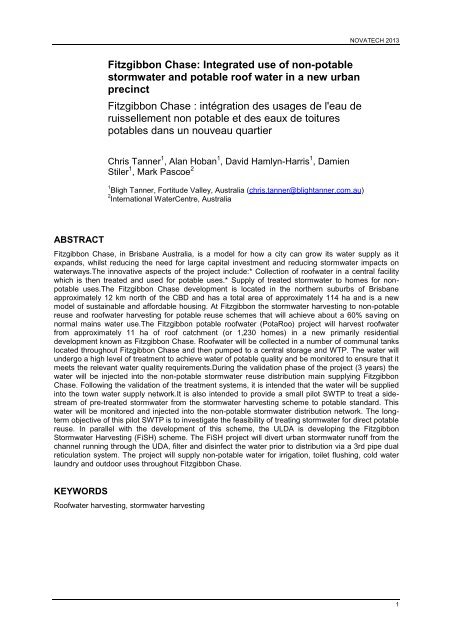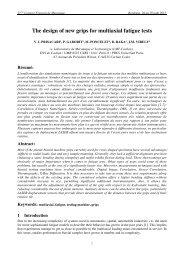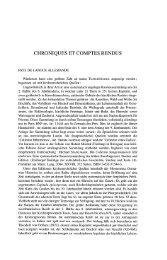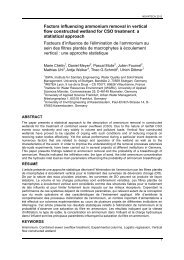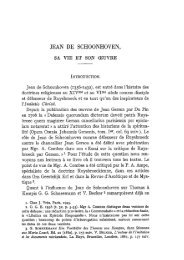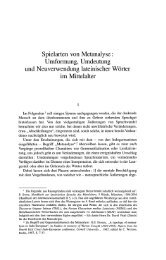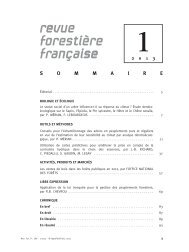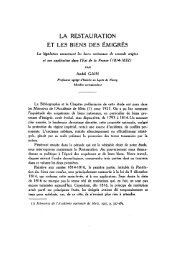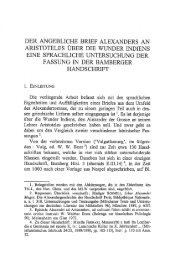communication novatech
communication novatech
communication novatech
Create successful ePaper yourself
Turn your PDF publications into a flip-book with our unique Google optimized e-Paper software.
NOVATECH 2013<br />
Fitzgibbon Chase: Integrated use of non-potable<br />
stormwater and potable roof water in a new urban<br />
precinct<br />
Fitzgibbon Chase : intégration des usages de l'eau de<br />
ruissellement non potable et des eaux de toitures<br />
potables dans un nouveau quartier<br />
Chris Tanner 1 , Alan Hoban 1 , David Hamlyn-Harris 1 , Damien<br />
Stiler 1 , Mark Pascoe 2<br />
1 Bligh Tanner, Fortitude Valley, Australia (chris.tanner@blightanner.com.au)<br />
2 International WaterCentre, Australia<br />
ABSTRACT<br />
Fitzgibbon Chase, in Brisbane Australia, is a model for how a city can grow its water supply as it<br />
expands, whilst reducing the need for large capital investment and reducing stormwater impacts on<br />
waterways.The innovative aspects of the project include:* Collection of roofwater in a central facility<br />
which is then treated and used for potable uses.* Supply of treated stormwater to homes for nonpotable<br />
uses.The Fitzgibbon Chase development is located in the northern suburbs of Brisbane<br />
approximately 12 km north of the CBD and has a total area of approximately 114 ha and is a new<br />
model of sustainable and affordable housing. At Fitzgibbon the stormwater harvesting to non-potable<br />
reuse and roofwater harvesting for potable reuse schemes that will achieve about a 60% saving on<br />
normal mains water use.The Fitzgibbon potable roofwater (PotaRoo) project will harvest roofwater<br />
from approximately 11 ha of roof catchment (or 1,230 homes) in a new primarily residential<br />
development known as Fitzgibbon Chase. Roofwater will be collected in a number of communal tanks<br />
located throughout Fitzgibbon Chase and then pumped to a central storage and WTP. The water will<br />
undergo a high level of treatment to achieve water of potable quality and be monitored to ensure that it<br />
meets the relevant water quality requirements.During the validation phase of the project (3 years) the<br />
water will be injected into the non-potable stormwater reuse distribution main supplying Fitzgibbon<br />
Chase. Following the validation of the treatment systems, it is intended that the water will be supplied<br />
into the town water supply network.It is also intended to provide a small pilot SWTP to treat a sidestream<br />
of pre-treated stormwater from the stormwater harvesting scheme to potable standard. This<br />
water will be monitored and injected into the non-potable stormwater distribution network. The longterm<br />
objective of this pilot SWTP is to investigate the feasibility of treating stormwater for direct potable<br />
reuse. In parallel with the development of this scheme, the ULDA is developing the Fitzgibbon<br />
Stormwater Harvesting (FiSH) scheme. The FiSH project will divert urban stormwater runoff from the<br />
channel running through the UDA, filter and disinfect the water prior to distribution via a 3rd pipe dual<br />
reticulation system. The project will supply non-potable water for irrigation, toilet flushing, cold water<br />
laundry and outdoor uses throughout Fitzgibbon Chase.<br />
KEYWORDS<br />
Roofwater harvesting, stormwater harvesting<br />
1
A6 - QUARTIERS RÉAMÉNAGEMENT / DISTRICT REDEVELOPMENT<br />
In what aspects does this case study:<br />
Integrate stormwater?<br />
Stormwater is harvested, treated, and then supplied to 1300 homes for non-potable uses. Roofwater is<br />
harvested from these homes, and collected into a central location and treated to drinking water<br />
standards<br />
Has a sustainable approach?<br />
It reduces the demand on the potable water supply by 60% whilst reducing stormwater volumes and<br />
pollutants reaching the receiving environment.<br />
Has a multi-actor approach?<br />
The Japanese and Australian governments invested in the project, and it involves several government<br />
and private sector organisations.<br />
Is innovative?<br />
It is innovative in terms of its approach and scale.<br />
Is exemplary?<br />
The project has been visited by delegations from Japan, China, South Korea, Israel and Malaysia.<br />
Locally, the project has won an Australian Water Association Infrastructure Innovation Award (2012)<br />
and a Healthy Waterways Water Sensitive Urban Design Award (2012)<br />
Is applicable to other projects?<br />
Model for how a city can grow its water supply as it expands, whilst reducing the need for large capital<br />
investment and reducing stormwater impacts on waterways.<br />
2


